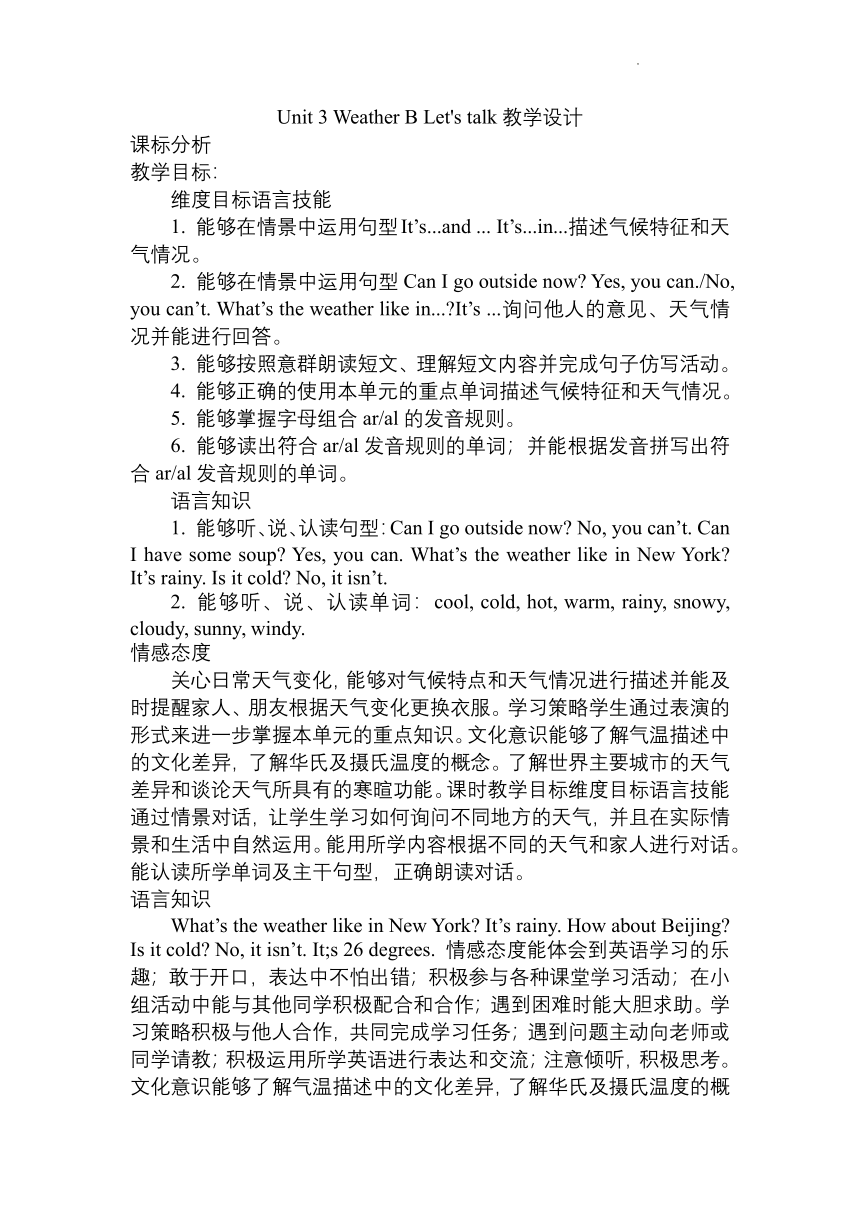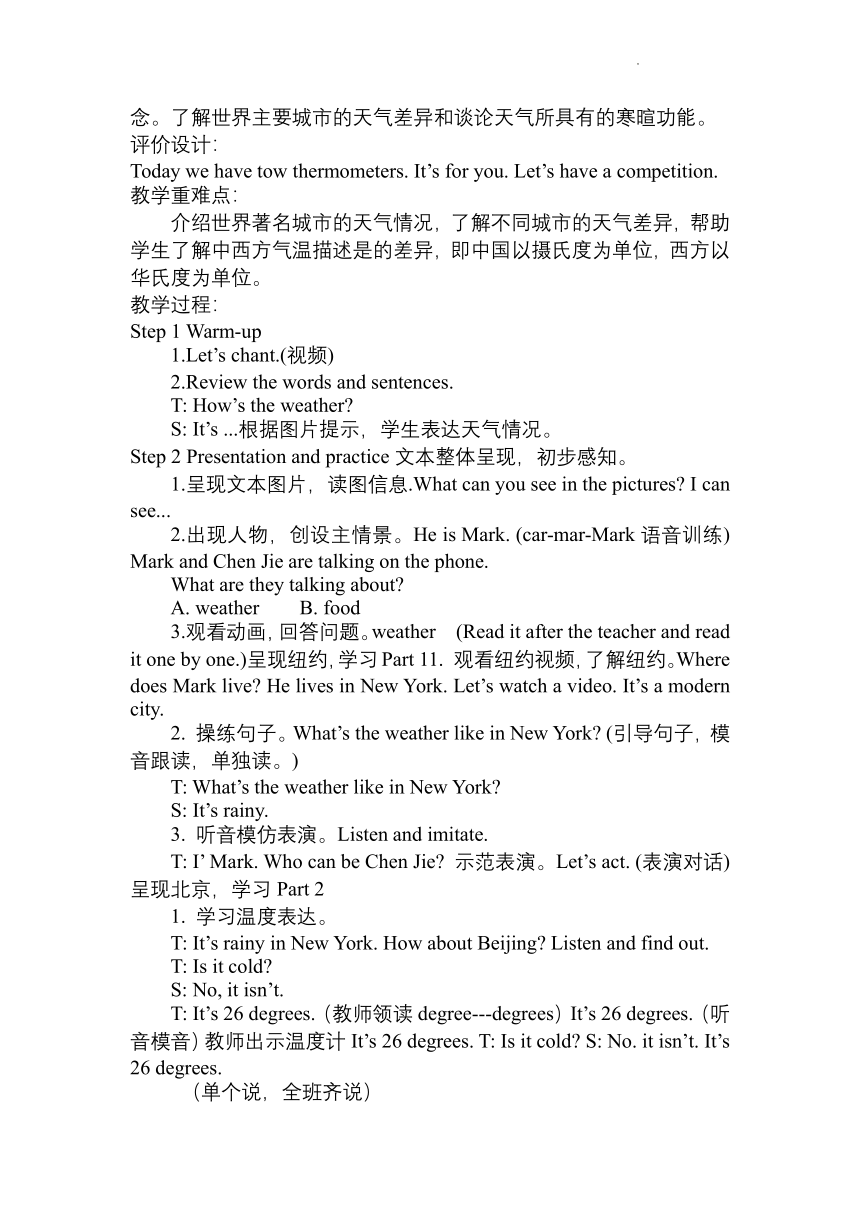Unit 3 Weather B Let's talk 教案(含反思)
文档属性
| 名称 | Unit 3 Weather B Let's talk 教案(含反思) |  | |
| 格式 | zip | ||
| 文件大小 | 29.9KB | ||
| 资源类型 | 教案 | ||
| 版本资源 | 人教版(PEP) | ||
| 科目 | 英语 | ||
| 更新时间 | 2022-05-23 22:02:05 | ||
图片预览


文档简介
Unit 3 Weather B Let's talk教学设计
课标分析
教学目标:
维度目标语言技能
1. 能够在情景中运用句型It’s...and ... It’s...in...描述气候特征和天气情况。
2. 能够在情景中运用句型Can I go outside now Yes, you can./No, you can’t. What’s the weather like in... It’s ...询问他人的意见、天气情况并能进行回答。
3. 能够按照意群朗读短文、理解短文内容并完成句子仿写活动。
4. 能够正确的使用本单元的重点单词描述气候特征和天气情况。
5. 能够掌握字母组合ar/al的发音规则。
6. 能够读出符合ar/al发音规则的单词;并能根据发音拼写出符合ar/al发音规则的单词。
语言知识
1. 能够听、说、认读句型:Can I go outside now No, you can’t. Can I have some soup Yes, you can. What’s the weather like in New York It’s rainy. Is it cold No, it isn’t.
2. 能够听、说、认读单词:cool, cold, hot, warm, rainy, snowy, cloudy, sunny, windy.
情感态度
关心日常天气变化,能够对气候特点和天气情况进行描述并能及时提醒家人、朋友根据天气变化更换衣服。学习策略学生通过表演的形式来进一步掌握本单元的重点知识。文化意识能够了解气温描述中的文化差异,了解华氏及摄氏温度的概念。了解世界主要城市的天气差异和谈论天气所具有的寒暄功能。课时教学目标维度目标语言技能通过情景对话,让学生学习如何询问不同地方的天气,并且在实际情景和生活中自然运用。能用所学内容根据不同的天气和家人进行对话。能认读所学单词及主干句型,正确朗读对话。
语言知识
What’s the weather like in New York It’s rainy. How about Beijing Is it cold No, it isn’t. It;s 26 degrees. 情感态度能体会到英语学习的乐趣;敢于开口,表达中不怕出错;积极参与各种课堂学习活动;在小组活动中能与其他同学积极配合和合作;遇到困难时能大胆求助。学习策略积极与他人合作,共同完成学习任务;遇到问题主动向老师或同学请教;积极运用所学英语进行表达和交流;注意倾听,积极思考。文化意识能够了解气温描述中的文化差异,了解华氏及摄氏温度的概念。了解世界主要城市的天气差异和谈论天气所具有的寒暄功能。
评价设计:
Today we have tow thermometers. It’s for you. Let’s have a competition.
教学重难点:
介绍世界著名城市的天气情况,了解不同城市的天气差异,帮助学生了解中西方气温描述是的差异,即中国以摄氏度为单位,西方以华氏度为单位。
教学过程:
Step 1 Warm-up
1.Let’s chant.(视频)
2.Review the words and sentences.
T: How’s the weather
S: It’s ...根据图片提示,学生表达天气情况。
Step 2 Presentation and practice文本整体呈现,初步感知。
1.呈现文本图片,读图信息.What can you see in the pictures I can see...
2.出现人物,创设主情景。He is Mark. (car-mar-Mark语音训练) Mark and Chen Jie are talking on the phone.
What are they talking about
A. weather B. food
3.观看动画,回答问题。weather (Read it after the teacher and read it one by one.)呈现纽约,学习Part 11. 观看纽约视频,了解纽约。Where does Mark live He lives in New York. Let’s watch a video. It’s a modern city.
2. 操练句子。What’s the weather like in New York (引导句子,模音跟读,单独读。)
T: What’s the weather like in New York
S: It’s rainy.
3. 听音模仿表演。Listen and imitate.
T: I’ Mark. Who can be Chen Jie 示范表演。Let’s act. (表演对话)呈现北京,学习Part 2
1. 学习温度表达。
T: It’s rainy in New York. How about Beijing Listen and find out.
T: Is it cold
S: No, it isn’t.
T: It’s 26 degrees.(教师领读degree---degrees)It’s 26 degrees.(听音模音)教师出示温度计It’s 26 degrees. T: Is it cold S: No. it isn’t. It’s 26 degrees.
(单个说,全班齐说)
温度计30
T: Is it cold
S: No. it isn’t. It’s 30 degrees.
T: Is it cold
S: Yes, it is. It’s 5 degrees.
T: Is it cold S: Yes, it is. It’s 2 degrees.(单个说,全班两大组问答练习。)
2. 文化渗透(摄氏度-华氏度)温度计回26
Is it cold
S: No. it isn’t. It’s 26 degrees.
T: Really Let’s listen. Chen Jie says it’s warm. But Mark says that’s cold. Why 学生用中文解说。Chen Jie thinks it’s 26 degrees Celsius. Mark thinks it’s 26 degrees Fahrenheit. It’s about 3 degrees below zero. It’s cold.
3. 听音模音Let’s listen and imitate.歌曲吟唱,整体文本模音Let’s sing a song together. Let’s listen and imitate.
Step 3 Production
1. 分层次操练输出语言。
We have three tasks.
A Read the talk, you can get 1 star.
B Act out, you can get 2 stars.
C Make a new one, you can get 3 stars.
Choose one task, let’s have a pair work.
2. 气温差距大城市介绍,关注全球变暖。Let’s know two cities. The first one, Oymyakon. It’s 71.2 degrees below zero. It’s very cold. It’s near the Arctic Circle. People wear thick clothes. The second one, Kuwait City. The capital of Kuwait. It’s cold somewhere, it’s hot somewhere. This is our beautiful earth. But it’s getting warmer and warmer. We must protect the earth. What should we do Think it over and talk about it after class. 课堂检测家庭作业
Here is your homework:
1 listen and repeat.
2 Know something about the different cities different weather
根据课文内容,选择正确的答案。
1.---What’s the weather like in New York
--- A It’s sunny. B It’s rainy.
2.---How about Beijing
--- A It’s warm. B It’s cold.
3. It’s ______ degrees.
A 26 B 5
课后反思
本节课学生比较有兴趣,积极参与课堂,主动求知。
1.模仿读音:尽可能多的让学生模仿纯正的英语发音,提高了学生的语音语调,为日后学生的英语学习打好基础。
2.小组合作学习:学生在小组合作表演课文时,积极与同学配合,主动开口求助,大胆表演,体会到了学习英语的快乐。
3. 自编歌曲:教师自编的歌曲,曲调熟悉自然,歌词朗朗上口,涵盖了文本的主干句型和基本内容,形式活泼,有助于提高学生的学习兴趣。
4. 文化拓展:通过视频等手段,学生了解了纽约城市的基本情况,了解世界不同地区的天气差异及中西方对于摄氏及华氏的文化差异,关注全球变暖的现象,引发思考,开拓了眼界。
不足之处:
在读图片信息表达时,学生在表述时语句出现错误,综合语言运用能还应提高。
课标分析
教学目标:
维度目标语言技能
1. 能够在情景中运用句型It’s...and ... It’s...in...描述气候特征和天气情况。
2. 能够在情景中运用句型Can I go outside now Yes, you can./No, you can’t. What’s the weather like in... It’s ...询问他人的意见、天气情况并能进行回答。
3. 能够按照意群朗读短文、理解短文内容并完成句子仿写活动。
4. 能够正确的使用本单元的重点单词描述气候特征和天气情况。
5. 能够掌握字母组合ar/al的发音规则。
6. 能够读出符合ar/al发音规则的单词;并能根据发音拼写出符合ar/al发音规则的单词。
语言知识
1. 能够听、说、认读句型:Can I go outside now No, you can’t. Can I have some soup Yes, you can. What’s the weather like in New York It’s rainy. Is it cold No, it isn’t.
2. 能够听、说、认读单词:cool, cold, hot, warm, rainy, snowy, cloudy, sunny, windy.
情感态度
关心日常天气变化,能够对气候特点和天气情况进行描述并能及时提醒家人、朋友根据天气变化更换衣服。学习策略学生通过表演的形式来进一步掌握本单元的重点知识。文化意识能够了解气温描述中的文化差异,了解华氏及摄氏温度的概念。了解世界主要城市的天气差异和谈论天气所具有的寒暄功能。课时教学目标维度目标语言技能通过情景对话,让学生学习如何询问不同地方的天气,并且在实际情景和生活中自然运用。能用所学内容根据不同的天气和家人进行对话。能认读所学单词及主干句型,正确朗读对话。
语言知识
What’s the weather like in New York It’s rainy. How about Beijing Is it cold No, it isn’t. It;s 26 degrees. 情感态度能体会到英语学习的乐趣;敢于开口,表达中不怕出错;积极参与各种课堂学习活动;在小组活动中能与其他同学积极配合和合作;遇到困难时能大胆求助。学习策略积极与他人合作,共同完成学习任务;遇到问题主动向老师或同学请教;积极运用所学英语进行表达和交流;注意倾听,积极思考。文化意识能够了解气温描述中的文化差异,了解华氏及摄氏温度的概念。了解世界主要城市的天气差异和谈论天气所具有的寒暄功能。
评价设计:
Today we have tow thermometers. It’s for you. Let’s have a competition.
教学重难点:
介绍世界著名城市的天气情况,了解不同城市的天气差异,帮助学生了解中西方气温描述是的差异,即中国以摄氏度为单位,西方以华氏度为单位。
教学过程:
Step 1 Warm-up
1.Let’s chant.(视频)
2.Review the words and sentences.
T: How’s the weather
S: It’s ...根据图片提示,学生表达天气情况。
Step 2 Presentation and practice文本整体呈现,初步感知。
1.呈现文本图片,读图信息.What can you see in the pictures I can see...
2.出现人物,创设主情景。He is Mark. (car-mar-Mark语音训练) Mark and Chen Jie are talking on the phone.
What are they talking about
A. weather B. food
3.观看动画,回答问题。weather (Read it after the teacher and read it one by one.)呈现纽约,学习Part 11. 观看纽约视频,了解纽约。Where does Mark live He lives in New York. Let’s watch a video. It’s a modern city.
2. 操练句子。What’s the weather like in New York (引导句子,模音跟读,单独读。)
T: What’s the weather like in New York
S: It’s rainy.
3. 听音模仿表演。Listen and imitate.
T: I’ Mark. Who can be Chen Jie 示范表演。Let’s act. (表演对话)呈现北京,学习Part 2
1. 学习温度表达。
T: It’s rainy in New York. How about Beijing Listen and find out.
T: Is it cold
S: No, it isn’t.
T: It’s 26 degrees.(教师领读degree---degrees)It’s 26 degrees.(听音模音)教师出示温度计It’s 26 degrees. T: Is it cold S: No. it isn’t. It’s 26 degrees.
(单个说,全班齐说)
温度计30
T: Is it cold
S: No. it isn’t. It’s 30 degrees.
T: Is it cold
S: Yes, it is. It’s 5 degrees.
T: Is it cold S: Yes, it is. It’s 2 degrees.(单个说,全班两大组问答练习。)
2. 文化渗透(摄氏度-华氏度)温度计回26
Is it cold
S: No. it isn’t. It’s 26 degrees.
T: Really Let’s listen. Chen Jie says it’s warm. But Mark says that’s cold. Why 学生用中文解说。Chen Jie thinks it’s 26 degrees Celsius. Mark thinks it’s 26 degrees Fahrenheit. It’s about 3 degrees below zero. It’s cold.
3. 听音模音Let’s listen and imitate.歌曲吟唱,整体文本模音Let’s sing a song together. Let’s listen and imitate.
Step 3 Production
1. 分层次操练输出语言。
We have three tasks.
A Read the talk, you can get 1 star.
B Act out, you can get 2 stars.
C Make a new one, you can get 3 stars.
Choose one task, let’s have a pair work.
2. 气温差距大城市介绍,关注全球变暖。Let’s know two cities. The first one, Oymyakon. It’s 71.2 degrees below zero. It’s very cold. It’s near the Arctic Circle. People wear thick clothes. The second one, Kuwait City. The capital of Kuwait. It’s cold somewhere, it’s hot somewhere. This is our beautiful earth. But it’s getting warmer and warmer. We must protect the earth. What should we do Think it over and talk about it after class. 课堂检测家庭作业
Here is your homework:
1 listen and repeat.
2 Know something about the different cities different weather
根据课文内容,选择正确的答案。
1.---What’s the weather like in New York
--- A It’s sunny. B It’s rainy.
2.---How about Beijing
--- A It’s warm. B It’s cold.
3. It’s ______ degrees.
A 26 B 5
课后反思
本节课学生比较有兴趣,积极参与课堂,主动求知。
1.模仿读音:尽可能多的让学生模仿纯正的英语发音,提高了学生的语音语调,为日后学生的英语学习打好基础。
2.小组合作学习:学生在小组合作表演课文时,积极与同学配合,主动开口求助,大胆表演,体会到了学习英语的快乐。
3. 自编歌曲:教师自编的歌曲,曲调熟悉自然,歌词朗朗上口,涵盖了文本的主干句型和基本内容,形式活泼,有助于提高学生的学习兴趣。
4. 文化拓展:通过视频等手段,学生了解了纽约城市的基本情况,了解世界不同地区的天气差异及中西方对于摄氏及华氏的文化差异,关注全球变暖的现象,引发思考,开拓了眼界。
不足之处:
在读图片信息表达时,学生在表述时语句出现错误,综合语言运用能还应提高。
